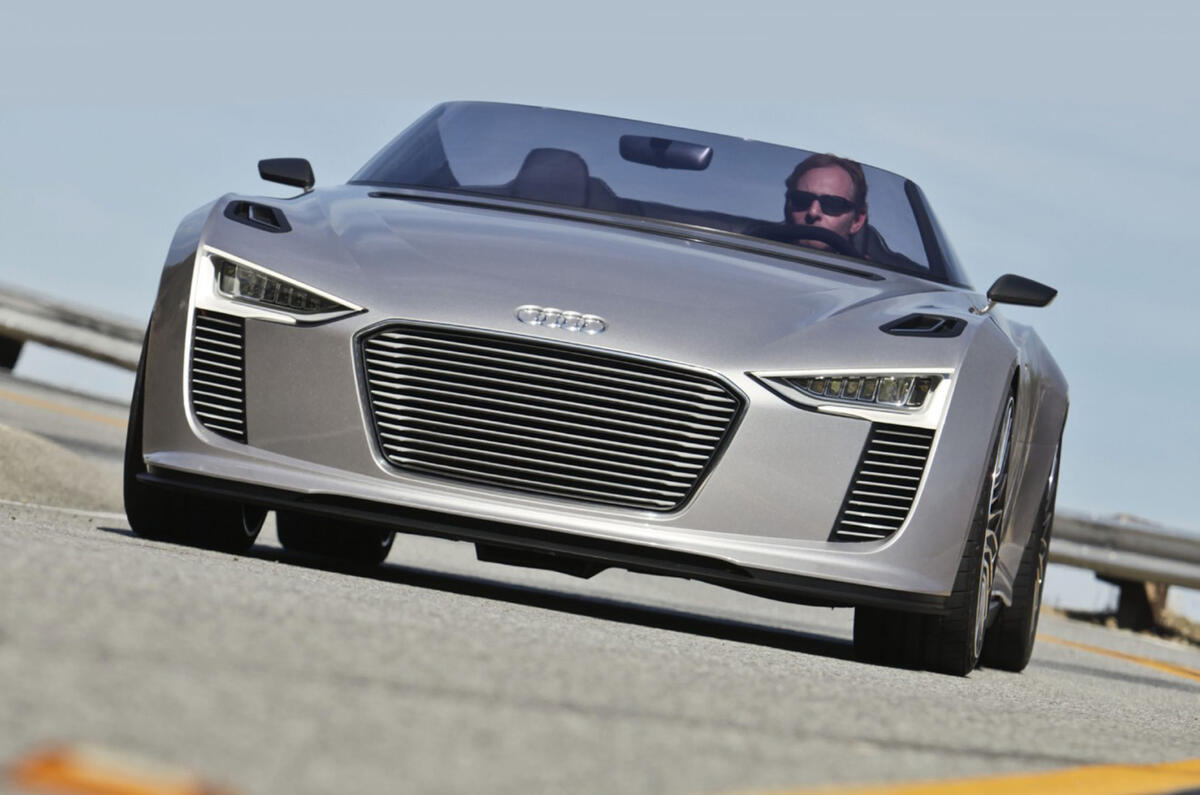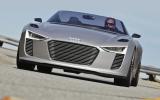What is it?
The Audi e-tron Spyder – a four wheel drive plug-in diesel-electric hybrid concept car. The new open top follows the earlier e-tron coupe, previewing a new mid-engined roadster that has been conceived to join the Audi line-up as part of on-going efforts to provide the German car maker with a more sporting profile.
Nothing is official just yet, although Ingolstadt officials suggest a production version of the e-tron Spyder sporting a more conventional petrol engine could sit above the TT both in position and price, acting as junior R8.
In concept car form, the new Audi is based around a unique aluminium spaceframe, gets an all-carbonfibre body and borrows chassis components from the TT RS (double wishbone front suspension) and R8 (double wishbone rear suspension).
At 4060mm in length, 1810mm in width and 1110mm in height, the new Audi is 371mm shorter, 219mm narrower and, owing to its cut down windscreen, 142mm lower than the soon-to-be-facelifted R8. The concept car tips the scales at 1650kg.
For a one-off, the e-tron Spyder boasts truly impressive levels of build quality – on the outside, at least. Open up its rear bodywork, though, and you’re reminded it is very much a prototype. Power comes from a mid-mounted twin-turbocharged 3.0-litre V6 common rail diesel engine producing 300bhp and 480lb ft of torque. Additional performance is provided by a pair of brushless electric motors sited up front that provide 88bhp and 260lb ft. Together the e-tron Spyder’s diesel engine and electric motors produce a combined 388bhp and mighty 740lb ft of torque, although that latter figure is a little misleading as it is not all available at once, depending rather on engine revs.
The reserves of the diesel engine were originally planned to be channeled to the rear wheels via a seven speed double clutch gearbox located behind the engine. However, packaging concerns has seen it been replaced by Audi’s stepless Multitronic CVT. The pair of electric motors, meanwhile, drive through a single speed transmission to the front wheels, a layout which provides the new Audi part time four-wheel drive.
Electrical energy for the motors is supplied by a 9.1kWh battery sited above the electric motors in the nose. It is claimed to provide the e-tron Spyder an all-electric zero emission range of around 31 miles at speeds up to 37mph.
Recharging of the battery occurs both on the run, as kinetic energy is collected under braking and on periods of trailing throttle, and by plug in means. In combined diesel-electric mode, the e-tron Spyder is theoretically capable of hitting 62mph in just 4.4sec and reaching a top speed limited to 155mph.
It is, in theory at least, also incredibly frugal, with combined cycle diesel consumption is put at 128.4mpg – a figure that equates to just 59g/km of CO2 emissions. With a 50-litre fuel tank, it could achieve more than 600 miles on a combination of both diesel and electric power.
What’s it like?
With next-to-no overhangs and considerable width relative to its length, it possesses a wonderfully confident appearance that is enhanced by the 245/35 (front) and 265/35 (rear) profile rubber lurking underneath its huge wheel houses.
You enter the cabin through conventional front hinged doors, stepping over a wide sill and dropping down into narrow, low set seats. The dashboard is horizontal plane of leather-bound aluminium and carbonfibre. It is terrifically simple in design.





















Join the debate
Add your comment
Re: Audi e-tron Spyder
The combined economy is presumably calculated based on the assumption that you start with a fully charged battery and run it down. The 600 (55MPG) mile range is presumably calculated on the assumption that you drive it all in one go and don't get a chance to re-charge the battery. Spread that driving over a longer time period and give yourself time to recharge in between and the diesel will last longer (giving you better MPG and a bigger range), at the expense of an increased electricity bill.
As ever, what actually economy you get from a range extender depends massively on how you use it.
Re: Audi e-tron Spyder
If Audi do start making hybrids I hope they stick to using diesel engines. Volvo is bringing out a V60 diesel hybrid but what will the price be.
Re: Audi e-tron Spyder